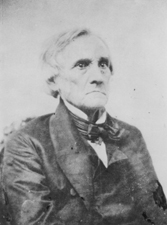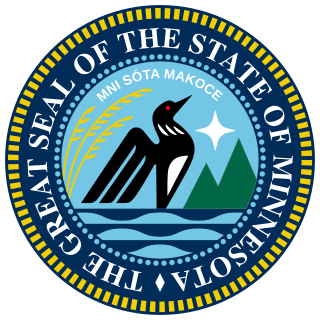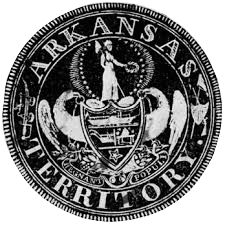Related Research Articles
The following is timeline of events surrounding the Toledo War, a mostly bloodless conflict between the State of Ohio and the Michigan Territory in 1835–36, over a 468-square-mile (1,210 km2) disputed region along their common border, now known as the Toledo Strip after its major city.

The Territory of Michigan was an organized incorporated territory of the United States that existed from June 30, 1805, until January 26, 1837, when the final extent of the territory was admitted to the Union as the State of Michigan. Detroit was the territorial capital.

The Territory of Wisconsin was an organized and incorporated territory of the United States that existed from July 3, 1836, until May 29, 1848, when an eastern portion of the territory was admitted to the Union as the State of Wisconsin. Belmont was initially chosen as the capital of the territory. In 1837, the territorial legislature met in Burlington, just north of the Skunk River on the Mississippi, which became part of the Iowa Territory in 1838. In that year, 1838, the territorial capital of Wisconsin was moved to Madison.

The Indiana Territory, officially the Territory of Indiana, was created by an organic act that President John Adams signed into law on May 7, 1800, to form an organized incorporated territory of the United States that existed from July 4, 1800, to December 11, 1816, when the remaining southeastern portion of the territory was admitted to the Union as the state of Indiana. The territory originally contained approximately 259,824 square miles (672,940 km2) of land, but its size was decreased when it was subdivided to create the Michigan Territory (1805) and the Illinois Territory (1809). The Indiana Territory was the first new territory created from lands of the Northwest Territory, which had been organized under the terms of the Northwest Ordinance of 1787. The territorial capital was the settlement around the old French fort of Vincennes on the Wabash River, until transferred to Corydon near the Ohio River in 1813.

William Woodbridge was a U.S. statesman in the states of Ohio and Michigan and in the Michigan Territory prior to statehood. He served as the second governor of Michigan and a United States senator from Michigan.

The Constitution of the State of Minnesota was initially approved by the residents of Minnesota Territory in a special election held on October 13, 1857, and was ratified by the United States Senate on May 11, 1858, marking the admittance of Minnesota to the Union. Nearly 120 amendments have been approved, with perhaps the most significant being a reorganization in 1974 to simplify the document, making it easier for modern readers to comprehend and reducing the extensive verbiage. It is believed that the constitution was amended twice prior to ratification.
The Minnesota Territorial Legislature was a bicameral legislative body created by the United States Congress in 1849 as the legislative branch of the government of the Territory of Minnesota. The upper chamber, the Council, and the lower chamber, the House of Representatives, first convened on September 3, 1849. The two chambers served as the territory's legislative body until Minnesota was admitted as a state on May 11, 1858, when the Territorial Legislature was replaced by the Minnesota Legislature.

The Sixth Michigan Territorial Council was a meeting of the legislative body governing Michigan Territory, known formally as the Legislative Council of the Territory of Michigan. The council met in Detroit in two regular sessions, one extra session, and one special session between January 7, 1834, and August 25, 1835, during the terms of George B. Porter and Stevens T. Mason as territorial governors.

The General Assembly of the Territory of Arkansas, commonly known as the General Assembly, was the legislature of the U.S. territory of Arkansas, from 1819 to 1835. The General Assembly was directly elected, albeit on a restricted franchise. Its legislative power was subject to veto by the appointed Governor.
The Michigan Territorial Council, known formally as the Legislative Council of the Territory of Michigan, was the legislative body of the Territory of Michigan from 1824 to 1835, when it was succeeded by the Michigan Legislature in anticipation of Michigan becoming a U.S. state. A session of the council including only members from what would become Wisconsin Territory met in 1836.

The Fifth Michigan Territorial Council was a meeting of the legislative body governing Michigan Territory, known formally as the Legislative Council of the Territory of Michigan. The council met in Detroit in two regular sessions between May 1, 1832, and April 23, 1833, during the term of George B. Porter as territorial governor.
The Fourth Michigan Territorial Council was a meeting of the legislative body governing Michigan Territory, known formally as the Legislative Council of the Territory of Michigan. The council met in Detroit in two regular sessions between May 11, 1830, and March 4, 1831, during the terms of Lewis Cass and George B. Porter as territorial governor.
The Third Michigan Territorial Council was a meeting of the legislative body governing Michigan Territory, known formally as the Legislative Council of the Territory of Michigan. The council met in Detroit in two regular sessions between May 5, 1828, and November 5, 1829, during the term of Lewis Cass as territorial governor.
The Second Michigan Territorial Council was a meeting of the legislative body governing Michigan Territory, known formally as the Legislative Council of the Territory of Michigan. The council met in Detroit in two regular sessions between November 2, 1826, and April 13, 1827, during the term of Lewis Cass as territorial governor.
The First Michigan Territorial Council was a meeting of the legislative body governing Michigan Territory, known formally as the Legislative Council of the Territory of Michigan. The council met in Detroit in two regular sessions between June 7, 1824, and April 21, 1825, during the term of Lewis Cass as territorial governor.
William Henry Puthuff, also spelled Puthoff, was an American soldier, businessman, and politician who served in the War of 1812 and occupied a number of government positions in the Territory of Michigan. In his role as Indian agent at Michilimackinac, he engaged in a multi-year conflict with John Jacob Astor and his American Fur Company. He was a member of the First Michigan Territorial Council and died while attending its first session.
Joseph Miller was an American pioneer and politician who served on the Michigan Territorial Council in 1825.
The 1823 Michigan Territorial Council election was held in the Territory of Michigan to elect the members of the territory's newly-formed legislative council.
The 1818 Michigan Territory general assembly referendum was held in the Territory of Michigan to determine whether a majority of the territory's freeholders favored the creation of a general legislative assembly to replace the system of governors and judges in effect at the time, as provided for by the Northwest Ordinance. The election was called by Territorial Governor Lewis Cass, and results showed a majority opposed changing the system of government.
References
- Carter, Clarence E., ed. (1943), The Territorial Papers of the United States, vol. 11, Washington, D.C.: Government Printing Office, retrieved October 15, 2019
- Laws of the Territory of Michigan, vol. 2, Lansing: W.S. George, State Printers, 1874, retrieved October 16, 2019
- Utley, Henry M.; Cutcheon, Byron M. (1906), Burton, Clarence M. (ed.), Michigan, as a Province, Territory, and State, the Twenty-Sixth Member of the Federal Union, vol. 2, Publishing Society of Michigan, hdl: 2027/mdp.35112104739232 , retrieved October 16, 2019